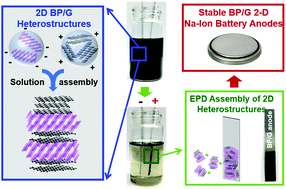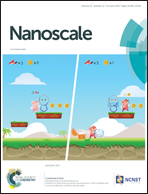Solvent mediated hybrid 2D materials: black phosphorus – graphene heterostructured building blocks assembled for sodium ion batteries†
Abstract
Here we demonstrate the broad capability to exploit interactions at different length scales in 2D materials to prepare macroscopic functional materials containing hybrid black phosphorus/graphene (BP/G) heterostructured building blocks. First, heterostructured 2D building blocks are self-assembled during co-exfoliation in the solution phase based on electrostatic attraction of different 2D materials. Second, electrophoretic deposition is used as a tool to assemble these building blocks into macroscopic films containing these self-assembled 2D heterostructures. Characterization of deposits formed using this technique elucidates the presence of stacked and sandwiched 2D heterostructures, and zeta potential measurements confirm the mechanistic interactions driving this assembly. Building on the exceptional sodium alloying capacity of BP, these materials were demonstrated as superior binder-free and additive-free anodes for sodium batteries with specific discharge capacity of 2365 mA h gP−1 and long stable cycling duration. This study demonstrates how controllable co-processing of 2D materials can enable material control for stacking and building block assembly relevant to broad future applications of 2D materials.

- This article is part of the themed collection: Editor’s Choice: 2D Materials for Energy Storage and Conversion


 Please wait while we load your content...
Please wait while we load your content...
